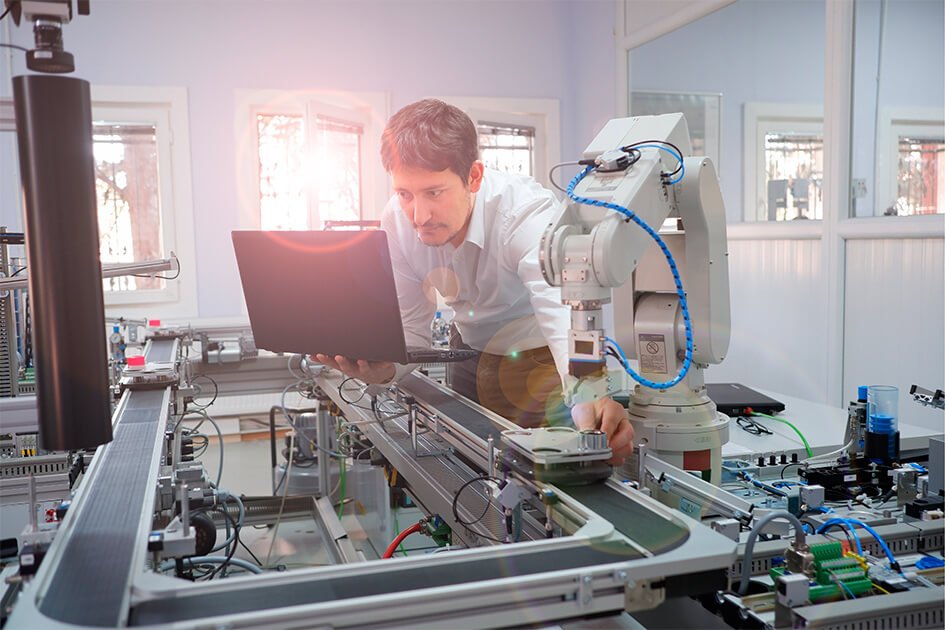You’re likely familiar with traditional commissioning but, just in case, let’s explore this from the ground up. The difference between real physical commissioning and virtual commissioning is that a real commissioning process involves testing directly on a real manufacturing, warehouse or hospital system (i.e. a machine), a real controller (i.e. PLC), and other necessary devices, including sensors and actuators. Virtual commissioning, however, uses virtual replicas of the system’s components and has several configuration options.
Virtual commissioning of a machine’s dynamics combines three important pieces: a digital model (sometimes referred to as a digital twin), the controller code that governs the motion and responds to sensor feedback, and a development environment that allows the two to run together.
For this to be practical for the manufacturing and automation industries, virtual models need to be sufficient for their usage outside of niche experts. The development of advanced, model-driven design practices has taken form in a digital twin. Besides the digital twin, the software standards for model connectivity have also seen drastic improvements. Together, these technologies are permitting the widespread practicality of virtual commissioning throughout the automation industry.
With the right tools in place, organizations can adopt virtual commissioning techniques for their machine design projects. They may use these techniques in order to reduce their overall commissioning time, to reduce commissioning costs, or to create a more reliable time to market for reputation purposes. While the applications and specifics can vary, a typical virtual commissioning process has many commonalities.

One major advantage is that it brings forward the commissioning phase. By using virtual prototypes, manufacturers, hospitals, and logistics operators can test control software in parallel with other engineering phases. This vastly reduces the risks of errors later in the development process.
Virtual commissioning also allows testing to be performed in a virtual environment. This commissioning approach allows for improved software quality and increased safety for workers. It also reduces the risk of damaging machinery if tests are carried out in real-time. And that’s just the start – commissioning with a digital twin brings so many more benefits to the table.
Faults and waste are inevitable during the development and operation of a machine, plant, hospital, or logistics operations. However, they can cause high costs and enormous effort when they are only detected during real commissioning. Integration in a plant, hospital and its EMDs, warehouse, and others involve risks as well. A solution could be a simulation with DHB4.0. Based on the digital twin of a new machine, hospital, or warehouse you’re able to parallelize engineering and process, test functions and detect faults, loss or gaps earlier, simulate the interplay of the machine in a line, patients being assisting by the doctor or nurses, products being separate in the warehouse and optimize operation while it’s running. Also, additional services can be offered based on the digital twin of the machine, hospital and its equipment’s, warehouse and it’s an inbound and outbound operation which can also be used for marketing and training purposes.
Virtual commissioning can be performed in a digital environment in the office instead of using expensive prototypes or the real machine, hospital, or warehouse on the operator’s site. Simulating the hospital, warehouse, machine, extensive testing allows to detect and fix errors in design and functions, making real commissioning a lot faster.
According to Six Sigma, error costs increase by a hospital, factor, warehouse of ten with each development step. As the simulation is possible to parallel to engineering, insights from virtual tests can improve engineering and process quality at an early stage. Testing the original PLC code with virtual controllers during real commissioning increases confidence, that the process is working as intended by the customer. This helps to avoid high error costs and wastes in your process.
Problems during real commissioning take time and raise costs for staff and materials, even more so with international projects. In contrast, everything can be tested in a safe way during virtual commissioning without needing the customer’s hospital, warehouse, and plant staff. This thorough troubleshooting significantly reduces the risks of errors or even defects in the real machines inside the factories, warehouse, and hospitals.
Machines inside factories, warehouses, and hospitals are supposed to work smoothly without downtime after commissioning. Optimizations or retrofits require access to a machine, which isn’t always possible. Thanks to the digital twin of the real machine it’s possible to validate all actions during the operation, thus reducing downtimes to a minimum.
In the manufacturing and automation industries, adopting new development techniques has become a key requirement for success. As demands on product requirements increase, design risks pose significant problems, threatening the success of those trying to keep pace. The technique of virtual commissioning promises to reduce the significant delays and costs associated with system integration and commissioning. While previously only possible by niche experts, powerful modeling tools and compatible information standards have paved the way for modern, accessible virtual commissioning solutions. This technology is heavily invested in by companies and research groups around the world, creating powerful techniques for model-based design. As these technologies develop, their role in the automation industry, hospitals, and warehouses will continue to grow into an essential component of product design.
Shorter time-to-market, cost reduction, better quality, and increased flexibility to adapt to market changes – most industrial, healthcare, and logistics companies must face big challenges, and digitization seems to be the answer. However, the variety of topics makes it difficult for companies to find the right way: The digital twin is one of them and can already exert a big impact now, and over the entire life cycle! See how you also can place the digital twin at the beginning of the digital transformation of your automation processes and see how DHB4.0 offers an easy start with the fastest return on investment.

North America: +1 (645) 221.6090
Europe: +351 (920) 799.717
LATAM: +55 (19) 9 8251.9536